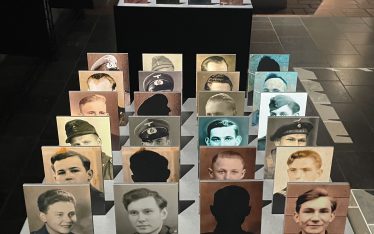What do you do when after two weeks of fighting one enemy (Germany), your country is stabbed in the back by another (Russia). Your troops are shielding retreating infantry troops with tanks and mobile artillery. You face annihilation or incarceration, so undefeated, you escape and fight on, “for our freedom and yours”. This is exactly what the 10-ta Pancerna Brygada Kawalerii – the 10th Motorised Cavalry Brigade did in late September 1939, led by Colonel Stanisław Maczek. It became the cornerstone of the 1-sza Dywizja Pancerna – the 1st Polish Armoured Division which went onto liberate large areas of North West Europe.
The ‘Baca’ Shepherd

Maczek shepherded his 10th Brigade through Hungary to France where under the Polish Government-in-Exile, he oversaw the rearming of his men. They fought in Champagne and Montbard holding back the progress of the Germans in the spring of 1940 as part of a force which grew to 84,500 Polish soldiers. Named ‘Baca’ (shepherd) by his men during his army career in Poland, Maczek was at the top of his military profession. He understood what it was to be a soldier, cared about his soldiers’ troubles and treated them with respect:
“The General didn’t demand. He expected, expected only the best from us. We knew this and we tried to give him that which was the best” Henryk Kątny.
After Paris fell to the Germans in June 1940, France capitulated, but the Polish government-in-exile again decided to fight on. Maczek had to destroy his vehicles and equipment and the government evacuated as many troops as they could by boat, a mere 24,000, to the United Kingdom, where they were sent to Scotland. General Sikorski the Commander-in-Chief created the 1-szy Polski Korpus – the I Polish Corps an independent Polish Armed Force alongside the Allies. The various units of the Corps defended 200 miles of Scottish coastline especially around Fife against possible invasion.


Maczek’s 10th brigade was merged with several other regiments and brigades to create the 1st Polish Armoured Division in February 1942 under his command as General. Men deported from Poland to the Russian gulags and released, were sent to join the Division and by 1943, Polish prisoners of war, previously forced to join the German army, were also added.
The magnificent hussars

Under an agreement with the British government, the Polish Armed Forces were allowed to keep their identity and military customs. The Armoured Division wore black berets, reminiscent of the black leather jackets of the 10th Brigade, which General Maczek continued to wear. Also the badge of a hussar’s helmet and wing on the left shoulder, continued the tradition of the invincible Polish cavalry dating back to the 16th century. By 1944 it numbered over 16,000 troops, 381 tanks and 4050 various motor vehicles, all painted with the hussar’s helmet and wing. The enemy called them the „Czarne Diabły” (Black Devils).
Normandy campaign
In June 1944, following the successful Allied D-Day landings in German-occupied Normandy, the 1st Armoured Division landed on Juno beach. The last troops arrived on 1 August, the first day of the Warsaw Uprising. They were assigned to the command of the 1st Canadian Army. part of the II Canadian Corps led by General Bernard Montgomery.

General Maczek is said never to have lost a battle and his successes included Canadian operations Totalise and Tractable against a formidable German defence. The Armoured Division became the cork which closed the Allied gap at Falaise through which German forces were escaping eastwards. Capturing Chambois and the Mont Ormel ridge, the Division at one point totally surrounded, withstood the assault. Nearly 100 enemy tanks were destroyed and about 5000 troops taken as prisoners of war but the Poles lost 325 soldiers, 1002 were wounded and 114 missing.
The Division advanced quickly as the Germans retreated, liberating the Belgian towns of Ypres, Tielt and Ghent. In September 1944, Polish forces fought at the battle of Axel, helping to capture Antwerp.
Breda, Netherlands
The town of Breda was an important communication hub for the Germans who created a strong defensive bastion against the Allies. Capturing Baarle Nassau and forcing the Mark Canal, on 29 October 1944 the 1st Armoured Division liberated the town. The Polish troops entered amidst a cheering population, in great relief from brutal occupation. They not only brought freedom but valuable supplies for the starving people.

Yet beyond the celebrations there was little rest for the troops as they moved forward. In the following days. Wherever Polish soldiers entered towns in France, Belgium and the Netherlands, they were enthusiastically welcomed by the local people showing their gratitude to their liberators. This continues with festivities and visits of Poles every year on the anniversaries of liberation.

Another link with Warsaw
After a short break, the Division crossed the border of north-west Germany in the spring of 1945. On 12 April, the tank soldiers liberated the Oberlangen POW camp, housing over 1,700 women, members of the Armia Krajowa (Polish Home Army). According to the agreement with the Germans as the Warsaw Uprising fell, these women, survivors of the Warsaw Uprising were recognised as soldiers.

The greatest success of the 1st Armoured Division and perhaps the crowning achievement of their campaign, was the capture of the port in Wilhelmshaven on 6 May 1945. The Germans surrendered one of the main Kriegsmarine bases to them.
Recognition
I often wonder why soldiers of the I Polish Corps didn’t receive the huge recognition they deserved. The daughter of a soldier in the 8th Brygada Kadrowa Strzelców (8th Cadre Rifle Brigade), called the ‘Krwawe Koszule‘ (bloodied shirts, after an officer who was shot in the ear) thinks it is because different parts of the Corps served under different Allied commands. Whilst the 1st Armoured Division fought under Canadian command, General Stanisław Sosabowski’s Independent Parachute brigade was attached to the First Allied Airborne Army in the bloody Market Garden operation. The Corps only worked together post-war from 1945 to 1947 under the overall command of General Maczek, occupying Germany.

Unwilling to return to a communist Poland and with the spirit of being undefeated, few soldiers went home, many settled in Scotland, others went to work in northern England in the hope the fight might go on. The majority of the Ex-Servicemen’s Clubs formed initially. were in Scotland. Certainly the troops didn’t feature in the Polish apparatus of state focused on London. General Maczek was stripped of his Polish citizenship by the new post-war communist government in Poland. Without a British army pension, as technically he was never in the British forces, he worked as a porter and bartender in a hotel in Edinburgh. He died in December 1994 aged 102 and is buried in Breda alongside some of his men.
The memoirs of General Maczek, edited by Jenny Grant will soon be launched.
You may also wish to read:
This article was written with help from the following sources:
- Armoured Wings: The 1st Armoured Division of General Stanisław Maczek, Wojskowe Centrum Edukacji Obywatelskiej 2022
- Urząd do spraw kombatantów i osób represjonowanych „Niepokonany Baca” – Waldemar Kowalski
- Poland’s contribution to the Allied Victory in the Second World War, Andrzej Suchcitz, Polish Ex-Combatants Association in Great Britain, 2011
- 1 Dywizja Pancerna gen. Maczka była pierwszą polską dużą jednostką pancerną, Tomasz Szczerbicki, Dzieje.pl, 25 October 2024


 1.Tracing Family History pre-WW2
1.Tracing Family History pre-WW2 2. Tracing Family History WW2
2. Tracing Family History WW2


